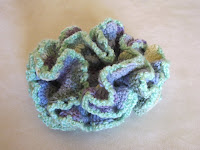Here is my newest creation and one I was able to keep track of as I made it so I can pass it on to you.
I love this little piece! It stands a little over 8" tall and the base is about 6" across.
As with all of my pieces, I have mostly been using my mom's leftover yarn stash that has been building for years. This is sport weight acrylic baby yarn in pink. The turquoise is also acrylic in worsted weight and the trim is #10 cotton crochet thread.
The anemone's are done using a G hook and the base with a J hook.
Tall Skinny One
- Ch 30 & join to make a circle
- sc in ea st til it measures 1 1/2"
- Dec 3 evenly in the next rnd
- Sc in ea st til it measures 3"
- Dec 3 evenly in the next rnd
- Sc in ea st til it measures 4 1/2"
- Dec 3 evenly in the next rnd
- Sc in ea st til it measures 5 1/2"
- Dec 3 evenly in the next rnd
- Sc in ea st til it measures 6"
- Dec 3 evenly in the next rnd
- Sc in ea st til the piece measures 6 1/2"
- 2 sc in ea outside loop of hte next rnd
- 2 sc in ea sc until it is ruffled as much as you like ( I did 5 rows) and tie off
- Join the cotton thread and sc in ea st around. You can do 2 in some sts to ease it if you want to.
- Tie off
Mid Sized Fat One
- Follow directions as for the tall skinny one until the piece measures 4 1/2"
- pick up the directions just after "measures 6 1/2" in the tall version
- Continue the 2sc in ea st for 5 rows and tie off
- Finish off with a round of cotton thread as before and tie off
Baby One
- ch 20 st and join to make a ring
- sc in ea st for 1"
- Dec 3 evenly in the next rnd
- Sc til the piece measures 2"
- Dec 3 evenly in the next rnd
- Sc til the piece measures 3"
- sc til the piece measures 4"
- pick up the directions just after "measures 6 1/2" in the tall version
- Continue the 2sc in ea st for 3 rows and tie off
- Finish off with a round of cotton thread as before and tie off
The Island
I used worsted weight yarn and a J hook
- ch 5 and join
- 14 dc in the center and join
- ch 2, dc in the same space, *dc in the nxt sp, 2dc in the nxt sp* to the end of the rnd
- Join and ch 2, *3dc in the nxt sp, 1dc in the nxt sp, 2dc in the nxt sp, 1dc in the next sp* repeat to the
end of the rnd, join, ch 2
- 2dc in ea st around and join.
- ch5, join to the nxt st all around and tie off
Stuff the anemone's lightly with fiber or polyfil and stitch them to the base with matching yarn.
That's it! Good luck.....
Check out my Eco Friendly product line of hand mades called WOOL-RENU™ at my Etsy Shop!
 Last Friday evening, Biddeford, Maine hosted one of their summer Art events. The Heart of Biddeford Headquarters on Maine street served as home for the Maine Crochet reef Project. The public was invited to stop by to see samples of work, get information about the reef and crochet patterns and visit with Ann Thompson to try their hand at crochet.
Last Friday evening, Biddeford, Maine hosted one of their summer Art events. The Heart of Biddeford Headquarters on Maine street served as home for the Maine Crochet reef Project. The public was invited to stop by to see samples of work, get information about the reef and crochet patterns and visit with Ann Thompson to try their hand at crochet.













